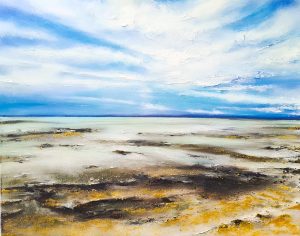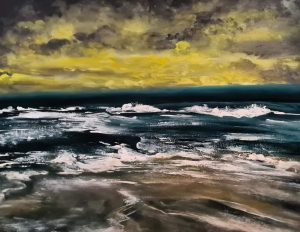Discover more about the history of art and what happened on this day in the past.

Andrew R Butler
Born 15 May 1896 in Yonkers NY, Butler was a landscape painter and etcher. His monochrome work often featured the landscapes of New England, as well as many works in Arizona. He was a student at the Art Students League of Frank DuMond, Luis Mora, and Joseph Pennell, and exhibited at the Salons of America, the Society of Independent Artists, and the Whitney Museum of American Art. He also achieved recognition abroad; the Bibliotheque Nationale in Paris holds a collection of his prints. This is: Mount Holly, in Vermont

Joan Miró
Born April 20, 1893 in Barcelona, Joan Miró is another of those artists that needs no introduction. But still hard to classify, if that is your thing. Choose between Fauvist, Surrealist, Expressionist or arguably even Cubist. This is: Horse, Pipe and Red Flower (from 1920)
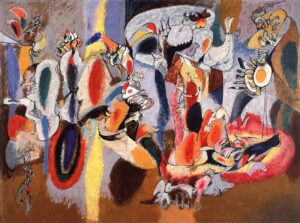
Arshile Gorky (Again)
Born April 15 1904 in Armenia, Gorky fled the Armenian Genocide as a child and arrived in the USA as a teenager. He became a powerful force in the art world, moving from landscapes through cubism to surrealism. Here we see: The Liver is the Cock’s Comb – it’s from the latter of those phases. Nighttime (along with two other paintings in the series; Enigma and Nostalgia) is (are?) perhaps a more famous painting, but loses out here due to the randomness of its title. He also painted two self portraits with his mother from a photograph he brought to the USA; his mother died before they reached America. His biography has Tragedy writ large upon it… Trivia fact #1: This is not the Gorky of Park fame – that’s Maxim, the writer – although apparently Arshile did occasionally tell people he was Maxim. Make what you will of that. And serendipitously, I downloaded the 1983 film to watch tonight – no connection but a pleasing coincidence. Trivia fact #2: I also thought that Gorky might by the inspiration for Rabo Karbekian in Kurt Vonnegut’s novel: Bluebeard (and posed that question in am #OTD post last year – hence Again).

Kenneth Noland
Born April 10, 1924 in Asheville NC, Noland is one of those artists that defies classification. Considered one of the best-known American color field painters (though not as well-known as Rothko and Pollock) in the 1950s he was considered an abstract expressionist and in the 1960s as a minimalist. Do labels matter? Let us know in the comments. In 2006 his Stripe Paintings were exhibited at the Tate in London. This is: New Day.

Robert Cocke
Born April 1, 1950 in Salzburg, Austria, Cocke is best known for his inventive (surrealist?) landscapes and still life paintings. According to Wikipedia, “He emerged in the 1980s, producing expressionistic figurative paintings with a socio-critical dimension that drew on Chicago Imagism and Funk art”. Which might just be another way of saying his art wouldn’t be out of place in a 1980s record shop specialising in prog rock. And that’s not intended as criticism. This is: Not what you think.

Oscar Gieberich
Born March 25, 1886 in New York City, Gieberich was known for a mix of modernist landscapes, seascapes and still life paintings. This picture, “Composition No.2 of New York City”, combines two of those three features. He was very active in Cape Cod, forming the Provincetown Art Association there, and many of his works feature the town, its inhabitants and local bird life.

Henry Farrer
Born 23 March 1844 in London, Farrer was the younger brother of Thomas, a well-known pre-raphaelite painter. Unlike Thomas, Henry was largely self-taught. In his late 20s, his landscape work shifted to the tonalist style for which he is best remembered. He was a co-founder of the American Watercolor Society and, unusually for the time, painted almost exclusively in water colours. His tonalist landscapes often depict a misty or cloudy landscape with water in the foreground, and the sun is often setting. The overall effect is one of stillness and the subdued, earthy colors give his works a meditative mood. This is: Winter scene in Moonlight
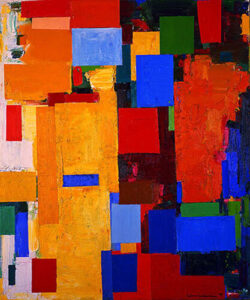
Hans Hofmann
Born March 21, 1880 in Weissenburg, Germany, Hofmann was a highly influential Abstract Expressionist painter. He was active in the early twentieth-century European avant-garde movement taking a deep understanding and synthesis of Symbolism, Neo-impressionism, Fauvism, and Cubism with him when he emigrated to the United States in 1932. Hofmann was also one of the most influential art teachers of the 20th century: he established an art school in Munich in 1915, building on the ideas of the Cubists, possibly the first modern school of art in the world. After emigrating to the United States, he reopened the school in both New York City and Provincetown, Massachusetts. His painting is characterized by a rigorous concern with pictorial structure and unity, spatial illusionism, and bold and expressive use of colour. This is: Equinox.
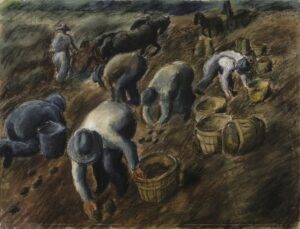
Schomer Lichtner
Born March 18, 1905 in Illinois, Lichtner was another beneficiary of Roosevelt’s New Deal in the 1930s. He worked in the sober tones of the social-realist style typical of the austere 1930s, and this painting: Potato Planting, is a classic example of the genre.

Gregory Orloff
Born 17 March in Kyiv, Ukraine, Orloff began his early art training with painter Vyacheslav Korenev at the Kyiv Academy of Art. He then continued his studies in the United States, first in New York and later studied at the Art Institute of Chicago, the city where he came to prominence. He exhibited portraits and scenes of daily urban life, with many of his works presenting a reassuring image in this post-depression era. This picture, Solitude, shows a lone woman enjoying the tranquility of a lakefront park, the cool water and lush gardens providing a welcome respite from the densely built surrounding Chicago metropolis.
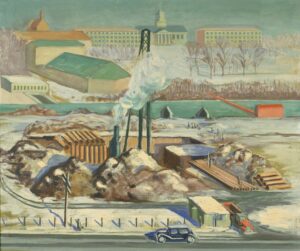
Holland Foster
Born 15 March 1906 in Iowa, Foster came to the artist world’s knowledge as a result of Roosevelt’s New Deal public works program. The program contained an Art Project, and this painting: Pipe Works, was one of its products.

Charles Warren Eaton
Born February 22 1857, in Albany, New York, Eaton was primarily a lanscape painter, with two distinctive styles. The first subject, intimate,and tonalist in style, typically contained pasture, trees and sometimes a small patch of water or stone fence. The second subject, grander in manner, was a landscape with a grouping of tall pine trees, often backlit with the glow of a setting sun. Many of his largest works were in this style, and he became known as “the pine tree painter”. He only rarely included human, or animal figures in his landscapes. This is: Edge of a pine forest at sunset



